Deriving our competitive advantage from genbaryoku, the SATO Group prizes human resources as the key to value creation and the most important assets we have. To practice genbaryoku and our corporate values that underlie it, we understand that we must bring out the best in our diverse workforce, tapping into different ideas, skills and experiences.
As the business world moves at an ever-increasing speed, we need new systems and functions to foster employees who can think and act on their own to initiate change.
Human capital objectives and measures
Human Resource Development
Global
Leadership development program
We offer leadership development programs for subsidiaries.
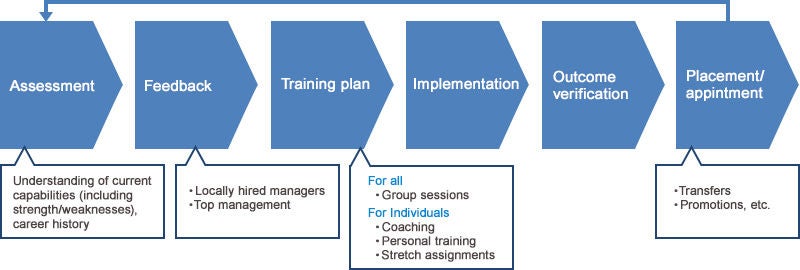
We assess locally-hired managers leading our subsidiaries to understand their strengths, areas of improvement and growth opportunities. As part of succession planning, we also identify other potential leaders and assess them too. In FY 2024, we used the assessment outcomes to plan and provide the necessary coaching and managerial training programs.
Training talent for key roles — which we started in FY 2024 — will be expanded in FY 2025 to target middle management at our subsidiaries. There will be different programs that serve in building people for senior managers and managers with direct reports. Some of this leadership training will be conducted in the Chinese language for subsidiaries in East Asia.
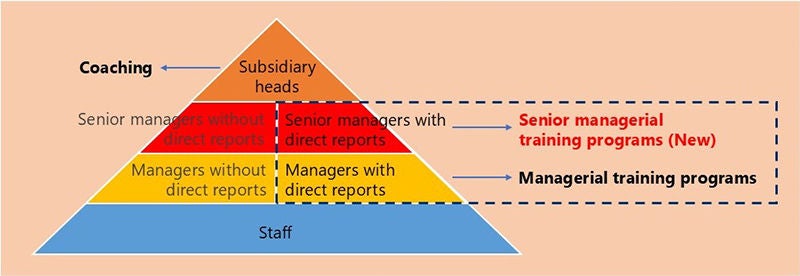
Our global learning system: E.D.G.E
We launched a learning management system called E.D.G.E in 2021. This name selected in-house is an acronym for “Engage, Develop, Grow and Evolve,” which explains the employee learning journey, starting from first engaging with the contents, to ultimately evolving and changing into a better version of themselves.
This e-learning system offering in-house and third-party courses is run on different platforms in and outside Japan due to language differences but supports content sharing across platforms.
E.D.G.E statistics on employee learning
| FY 2024 | ||
|---|---|---|
| Outside Japan | Japan | |
| Users (cumulative total) | 1,901 | 2,136 |
| Total e-learning hours | 25,690 | 14,213 |
| E-learning hours per user | 13.5 | 6.7 |
| Courses | 1,309 | 1,198 |
Online learning is convenient for employees in different locations and time zones. We have started different awards to motivate more employees to learn and enrol in courses, hoping to increasingly leverage the learning management system as a key pillar of our HR development strategy.
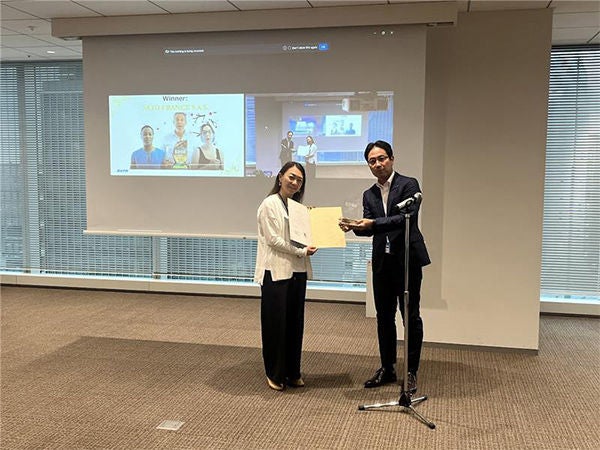
Using selected content from the learning system, we also launched SATO Dojo, a knowledge portal for our strategic partners, to drive more awareness of our products and services and build stronger partnerships globally.
Japan
SATO Campus
In April 2021, we established SATO Campus, aiming to not only strengthen human capital for sustainable value creation in line with our medium-term management plan, but also increase workplace satisfaction. To nurture talent, it is important that we meet employees' professional development needs and help them grow sustainably. SATO Campus has three key objectives:
- Train self-reliant and self-determining talent
- Develop understanding of corporate values and business value chain
- Create opportunities for employees to demonstrate strengths and take new challenges
With a central focus on realizing the career goals of our employees, SATO Campus offers not just training but also programs for job transfer or assignment and channels for fostering connections between employees, and between employees and their workplace. We will take a comprehensive approach to HR development through SATO Campus and further enrich its offerings to encourage employees to think creatively and act proactively.
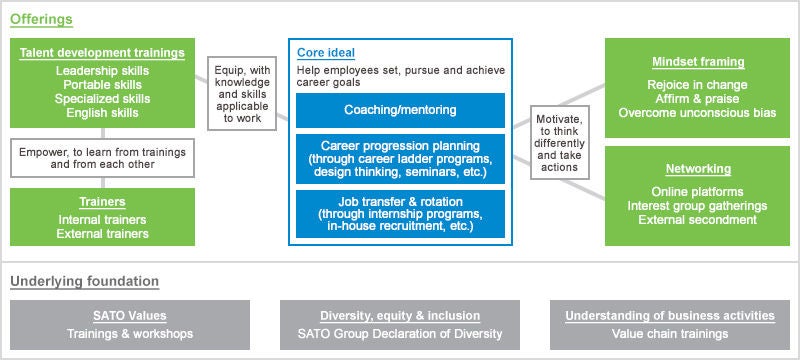 Overview of SATO Campus (incl. activities that are yet to start or still under consideration)
Overview of SATO Campus (incl. activities that are yet to start or still under consideration)
Career planning
Under SATO Campus, we are working to use the career ladder as an important HR development tool for employees to advance their careers following a clear skills and experience roadmap.
In parallel, we conduct trainings for employees in their third, 10th, 20th and 30th year of service to look back at their career paths and lives and plan ahead. These trainings are also offered to female employees and managers so that they can consciously use design thinking or help team members use design thinking for their careers.
100-year life expectancy is now the norm in Japan. As employees live longer lives, we want to keep them happy and healthy from learning new things and finding meaning in their work. In line with this, we are creating more opportunities for employees to rethink what they value most both in and outside of work.
Training statistics
| FY 2024 | ||
|---|---|---|
| Participants | Total hours | |
| Career planning for employees in their 10th year of service | 37 | 278 |
| Career planning for employees in their 20th year of service | 43 | 323 |
| Seminars for employees who reach 56 years of age | 75 | 788 |
| Career planning for managers | 409 | 1,457 |
| Career planning for female employees | 39 | 254 |
Career development support
We support employees in achieving the long-term goals they set from career planning.
Personal declaration of career aspirations
Employees define their current job goals and future direction, sharing their career vision with the company.
In-house recruitment
Departments post job openings to attract and recruit suitable talent from existing workforce.
Internal transfer
Employees can register their skills, job experiences and desired role, and apply for transfers, subject to the acceptance of the receiving department.
Global internship
Employees can apply for short-term on-the-job training programs at SATO subsidiaries outside Japan.
Tailored training by job level
Training needs differ for everyone, from new hires to upper management. We train new managers on the knowledge and skills they need to fulfill the responsibilities expected of their role. Managerial training programs teach managers to be self-reliant and self-determining, setting a good example for their team members to follow.
Training statistics
| FY 2024 | ||
|---|---|---|
| Participants | Total hours | |
| Onboarding training for new graduate hires | 41 | 6,560 |
| Onboarding training for mid-career hires | 102 | 1,530 |
| Site visits to the company factory in Iwate, Japan (for 2nd and 3rd year employees) | 43 | 473 |
| Training on company history and culture (by former board director) | 348 | 696 |
| Training for senior managers/experts | 32 | 338 |
| Training for new managers/experts | 138 | 1,155 |
| Training for new assistant managers, etc. | 114 | 830 |
| Training for new supervisors, etc. | 124 | 896 |
Value chain trainings
Value chain trainings in Japan aim to provide employees with a good understanding of our business and frontline operations. Through lectures and site visits, participants gain insights into SATO-specific keywords, business concepts and company operations. Going beyond their own jobs, they learn how every business activity connects us to our customers, and become more aware of how they can maximize the value of the customer experience we provide. This understanding fuels creativity and drives employees to think and take actions to improve their work. Value chain trainings also foster communication across departments and strengthen the fundamentals of company management. We plan to expand these trainings to cover the supply chains of our customers in different industries.
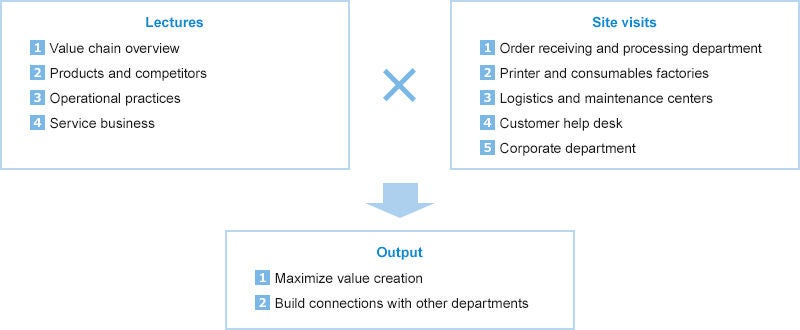
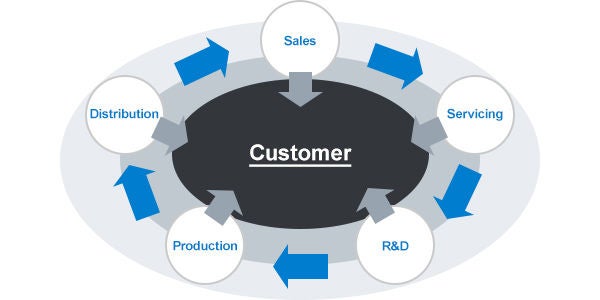 Our in-house value chain
Our in-house value chain
Value chain training statistics
| FY 2024 | |
|---|---|
| Training participants (cumulative total) | 215 |
Fostering auto-ID engineers
We encourage employees to take the qualifying exam that is offered by the Japan Automatic Identification Systems Association (JAISA) every year to support the development of auto-ID engineers. Over 800 employees have been certified to date. We also run the JAISA-sponsored annual seminar on auto-ID basics to improve employee literacy in the technology that is core to our business.
English promotion activities
To globalize our business, we have been actively promoting and supporting the use and learning of the English language in Japan since 2012, requiring employees to take CASEC (online test to evaluate English proficiency) annually starting 2013.
From FY 2022, we decided to expand the activity beyond Japan to other non-English speaking countries, while gearing it more toward employees who need it more. We are also incorporating the latest language e-learning tools and other effective channels to better support learning and development and enhance employee engagement globally.
| FY 2024 | ||
|---|---|---|
| Employees enrolled/subscribed | Completion rate | |
| Online English conversation classes | 205 | 82.4% |
| English learning apps | 311 | 50.1% |
Financial assistance for employee self-improvement
The company helps employees pay for job-related courses and certifications based on their needs.
Tuition reimbursement for correspondence courses
We cover full tuition for employees who register for correspondence courses and complete the course requirements within the specified timeframe.
| FY 2022 | FY 2023 | FY 2024 | |
|---|---|---|---|
| Employees who registered for courses | 280 | 283 | 319 |
| Employees who completed courses | 199 | 205 | 240 |
| Completion rate | 71.1% | 72.4% | 75.2% |
National/industry certification subsidy
We subsidize exam fees for employees who take and pass certification exams that are approved by the company.
